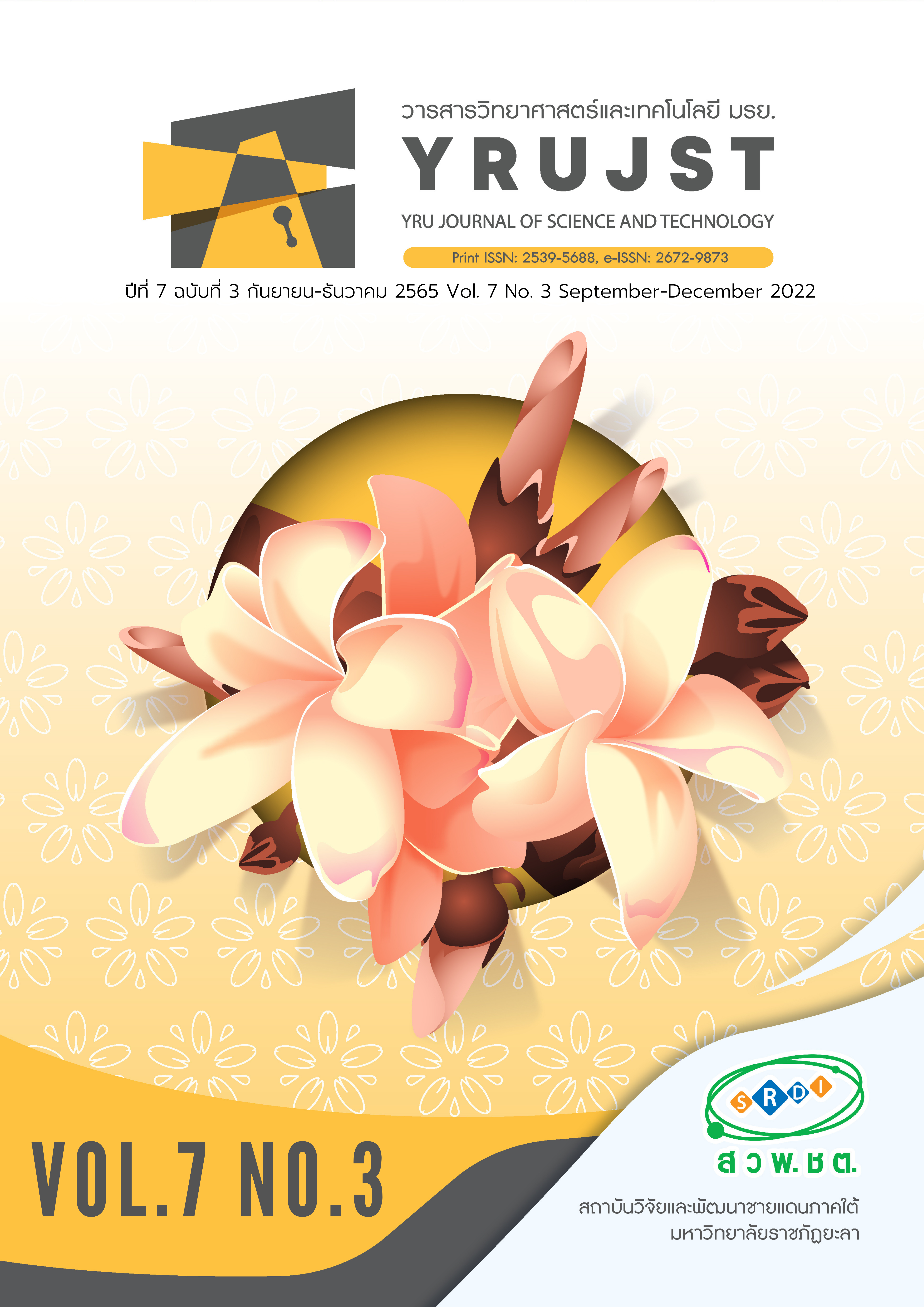การพัฒนาตู้ควบคุมอุณหภูมิสำหรับอนุบาลลูกไก่พื้นเมืองพันธุ์เหลืองหางขาว
Main Article Content
บทคัดย่อ
การวิจัยนี้เป็นการวิจัยแบบผสมผสาน (Mixed methods) มีวัตถุประสงค์เพื่อศึกษาและออกแบบตู้ควบคุมอุณหภูมิสำหรับอนุบาลลูกไก่พื้นเมืองเหลืองหางขาว เพื่อเพิ่มอัตราการเลี้ยงรอดของลูกไก่ระยะ 0 ถึง 6 สัปดาห์ เริ่มจากศึกษาลักษณะเฉพาะของพื้นที่โดยการวิจัยเชิงคุณภาพ ได้แก่ คัดเลือกกลุ่มตัวอย่างเกษตรกรแบบเฉพาะเจาะจง เก็บรวมรวมข้อมูลด้วยการสัมภาษณ์เชิงลึกร่วมกับการศึกษาลักษณะเฉพาะของพื้นที่ที่มีผลต่ออัตราการเลี้ยงรอดและการเจริญเติบโตพบว่า ผลการศึกษามีความสอดคล้องกันคือ อุณหภูมิอากาศช่วง 28 -32 องศาเซลเซียส หลังจากนั้นนำมากำหนดเป็นทรีทเมนต์เพื่อออกแบบและทดสอบตู้อนุบาลลูกไก่ด้วยการวิจัยเชิงปริมาณ วางแผนการทดลองแบบสุ่มสมบูรณ์ 4 ทรีเมนต์ จำนวน 3 ซ้ำ วิเคราะห์ความแปรปรวน และเปรียบเทียบค่าเฉลี่ยระหว่างทรีทเมนต์ที่ระดับนัยสำคัญ 0.05 (P<0.05) ผลการวิจัยพบว่า การออกแบบและสร้างตู้ควบคุมอุณหภูมิสำหรับอนุบาลลูกไก่ ซึ่งได้ตู้อนุบาลขนาด 100x150x80 ลูกบาศก์เซนติเมตร หุ้มด้วยฉนวน (โพลีโพพลีลิน) เพื่อกักเก็บพลังงานความร้อนในตู้ให้คงที่ ติดตั้งเครื่องควบคุมอุณหภูมิ เจาะรูด้านข้างและติดตั้งพัดลมเพื่อระบายอากาศ ติดตั้งหลอดเซรามิคเป็นแหล่งกำเนิดพลังงานความร้อน ผลการทดสอบพบว่า การควบคุมอุณหภูมิระหว่าง 3 ระดับ คือ 28±1 30±1 และ 32±1 องศาเซลเซียส มีอัตราการเลี้ยงรอดมากกว่าการไม่ควบคุมอุณหภูมิอย่างมีนัยสำคัญทางสถิติ (P<0.05) โดยอัตราการเจริญเติบโตเฉลี่ยต่อวันและค่าอัตราการเปลี่ยนอาหารเป็นน้ำหนักมีค่าไม่แตกต่างกันอย่างมีนัยสำคัญทางสถิติ (P>0.05) ดังนั้น จากการพัฒนาตู้ควบคุมอุณหภูมิสำหรับอนุบาลลูกไก่ โดยใช้การวิจัยแบบผสมผสานนี้ทำให้ได้ตู้อนุบาลลูกไก่ที่ควบคุมอุณหภูมิให้เหมาะสมต่อลูกไก่แต่ละช่วงอายุของการอนุบาลและสอดคล้องกับลักษณะเฉพาะพื้นที่
Article Details

อนุญาตภายใต้เงื่อนไข Creative Commons Attribution-NonCommercial-NoDerivatives 4.0 International License.
บทความ ข้อมูล เนื้อหา รูปภาพ ฯลฯ ที่ได้รับการเผยแพร่ในวารสารวิทยาศาสตร์และเทคโนโลยี มรย. นี้ ถือเป็นลิขสิทธิ์ของวารสารวิทยาศาสตร์และเทคโนโลยี มรย. หากบุคคลหรือหน่วยงานใดต้องการนำทั้งหมดหรือส่วนหนึ่งส่วนใดไปเผยแพร่ต่อหรือกระทำการใดๆ จะต้องได้รับอนุญาตเป็นลายลักษณ์อักษรจากวารสารวิทยาศาสตร์และเทคโนโลยี มรย. ก่อนเท่านั้น
เอกสารอ้างอิง
Asako, Y. & Nakamura, H. (1982). Heat transfer across a parellelogram shaped enclosure. Bulletin of JSME, 25, 1412-1424.
Bouafia, M., Hamimid, S. & Guellal, M. (2015). Non-Boussinessque convection in a square cavity with surface thermal radiation. International Journal of Thermal Sciences, 96, 236-247.
Changjan, A. (2015). Thermofluids for environment. Pathum Thani: Rangsit University Printing Company.
Cresswell, J. W. & Plano Clark, V. (2011). Designing and conducting mixed methods research (2nd ed.). U.S.A. SAGE Publications Ltd.
Department of Livestock Development. (2003). Handbook of native chicken raising. Bangkok: Agricultural Cooperative Printing Demonstrations of Thai co., Ltd. (in Thai)
Department of Livestock Development, Information and Communication Technology Center. (2021).
Data of livestock farmers and chickens in each provinces. from: https://opendata.nesdc.go.th/ dataset/d7681470-0120-47ab-8315-5cd28b9539c8/resource/1b116b37-ce19-415d-ae04-d734add184f/download/-2564.pdf
Faykaew, P. (2019). Effect of temperature light intensity and wind speed on feed conversion ratio in female broiler. Khon Laen Agr. J., 47(Suppl), 775-780. (in Thai)
Hinkle, D. E, William, W. & Stephen, G. J. (1998). Applied statistics for the behavior sciences (4th ed.).
New York: Houghton Mifflin.
Huo, X. & Na-Lampang, P. (2012). Thai crossbred chickens can be raised in a high stocking density. Asian Journal of Poultry Science, 6(4), 146-151.
Islam, M. S., Masum, M. A., Santa, D. H., Alam, M. J., & Ali, M. M. (2016). Establishment of cost effective brooding method for chicken. International Journal of Animal Resources, 1(2), 35-44.
Chalakbang, W. (2017). Mixed methods research. Nakhon Phanom University Journal, 7(2), 124-132.
Maksuwan, A. (2019). Application of the heat transfer for evaluated urban heat island intensity. Veridian E-Journal, Science and Technology Silapakorn Univesity, 6(1), 31-46. (in Thai)
Ngamvichaikit, A. (2015). Mixed method approach: Qualitative and quantitative research design. Journal of Modern Management Science, 13(1), 1-12. (in Thai)
Noiva, R. M., Menezes, A. C. & Peleterio, M. (2014). Influence of temperature and humidity manipulation on chicken embryonic development. BMC Veterinary Research, 10, 234.
Panchan, C. & Mahujchriyawong, J. (2012). Application of cleaner technology in cooling system process for broiler chicken husbandry. Pp. 526-532. In Proceedings of the 99th Kasetsart University Kamphaen Saen Campus Conference: Engineering, Science Technology and Environment. (in Thai)
Phothisita, C. (2019). Science and art of qualitative research (8th ed.). Bangkok: Chulalongkorn University Press. (in Thai)
Pontecha, P., Suriya, P. & Cansee, S. (2019). Development of semi-automatic Turkey chick rearing device. P. 1-8. In Proceedings of the 33rd conference of mechanical engineering network of Thailand. from: http://www.tsme.org/me-nett/me-nett2019/fullpaper/ETM/ETM025.pdf. Retrieved on 12 March 2022. (in Thai)
Soipeth, U., Chirarat, N., Chalermsan, N., Yeamkong, S., Rattanapradit, P., Laorodphan, N., et al. (2017). Diversity of Thai indigenous leuang Hang Kao Chicken follow standard of perfection in Phitsanulok Province. Khon Laen Agr. J., 1, 684-689. (in Thai)
Sarmiento-Garcia, A., Revilla, I. Abecia, J. A . & Palacios, C. (2021). Performance evaluation of two slow-medium growing chicken strains maintained under organic production system during different seasons. Animals, 11(1090), 1-13.
Somkuna, N., Somkuna, E. & Rachwicha, P. (2019). Handbook of development of native chicken by herbs. Documents of distribution on the project of knowledge management and technology transfer from research and innovations. Buriram: Vinai Printing 2019 Ltd. (in Thai)
Sriin, K. & Maksuwan, A. (2022). Tacit knowledge mangement in Moina (Moina macrocopa) culture with chlorella: A case study of Nakhon Si Thammarat College of Agriculture and Technology. Suranaree Journal of Social Science, 16(2), 1-21 (in Thai)
Vichan, L. (2019). The relationship between philosophy and research. Lectures Environmental Technology Philosophy for Agriculture. Agricultural Environmental Technology Branch. Faculty of Science and Technology Pathumwan Institute of Technology. (in Thai)
Yang, C., Zhang, Q., Zhang, W. & Xia, M. (2020). High thermal insulation and compressive strength polypropylene microcellular foams with honeycomb structure. Polymer Degradation and Stability, 183(5878), 109406. DOI: 10.1016/j.polymdegradstab.2020.109406.


